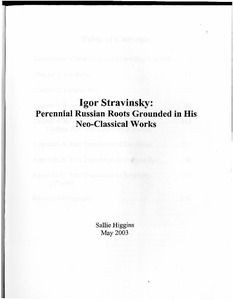| dc.rights.license | In Copyright | en_US |
| dc.creator | Higgins, Sallie Berry | |
| dc.date.accessioned | 2023-10-20T18:00:41Z | |
| dc.date.available | 2023-10-20T18:00:41Z | |
| dc.date.created | 2003 | |
| dc.identifier | WLURG038_Higgins_thesis_2003 | |
| dc.identifier.uri | https://dspace.wlu.edu/handle/11021/36432 | |
| dc.description.abstract | Stravinsky's works are typically categorized into three main periods of composition: Russian, Neo-Classical, and Serial. The most noteworthy works of his Russian phase, roughly 1902-1920, include the ballets made famous by Diaghilev's Ballets Ruses in Paris: Firebird (1910), Petrushka (1911), The Rite of Spring (1913), and The Nightingale (1914). The Neo-Classical period, approximately 1920 to 1950, includes works which revert to certain artistic ideals of eighteenth century Classicism. From the early 1950s until his death in 1971, Stravinsky once again completely altered his compositional vocabulary and embraced the dodecaphonic theories and serial techniques established by the Second Viennese School of Schoenberg in the 1920s. Although Stravinsky employs different stylistic techniques during these three different stages of composing, it seems likely that certain characteristics have become clearly Stravinskian, and may define his music with no regard for stylistic period. More specifically, traits typical of Stravinsky's Russian phase might be retained in his NeoClassical stage. This paper will analyze Les Noces, a ballet-cantata written between 1914 and 1923, as a typical Russian piece. Then the author will evaluate two of Stravinsky's Neo-Classical choral masterpieces, the opera-oratorio Oedipus Rex (1927) and Symphony of Psalms (1930) in order to determine if Russian features are employed in his NeoClassical works also. [From Introduction] | en_US |
| dc.format.extent | 164 pages | en_US |
| dc.language.iso | en_US | en_US |
| dc.rights | This material is made available for use in research, teaching, and private study, pursuant to U.S. Copyright law. The user assumes full responsibility for any use of the materials, including but not limited to, infringement of copyright and publication rights of reproduced materials. Any materials used should be fully credited with the source. | en_US |
| dc.rights.uri | http://rightsstatements.org/vocab/InC/1.0/ | en_US |
| dc.subject.other | Washington and Lee University -- Honors in Music | en_US |
| dc.title | Igor Stravinsky: Perennial Russian Roots Grounded in His Neo-Classical Works | en_US |
| dc.type | Text | en_US |
| dcterms.isPartOf | WLURG038 - Student Papers | en_US |
| dc.rights.holder | Higgins, Sallie Berry | en_US |
| dc.subject.fast | Stravinsky, Igor, 1882-1971 | en_US |
| dc.subject.fast | Criticism, interpretation, etc. | en_US |
| dc.subject.fast | Music -- Russian influences | en_US |
| local.department | Music | en_US |
